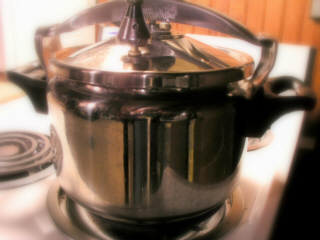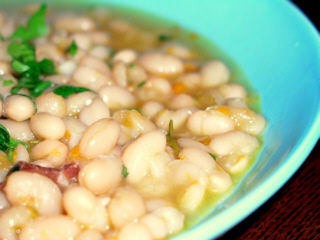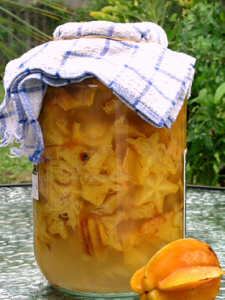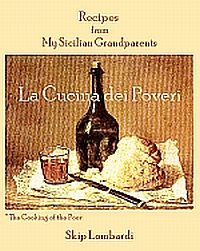Viva Cristoforo Colombo
October 6th, 2007
Cristoforo Colombo
Some of my friends have been checking in today, to ask how I plan to celebrate Columbus Day. Certainly, one component of my observance will be to use this blog to dispel any misunderstandings about that tawdry business with Joe Columbo.
I can see how misunderstandings have arisen. The guy’s name was Columbo, and he got whacked in public on Columbus Circle in midtown Manhattan. But contrary to the most popular misunderstanding, it happened months before Columbus Day—on June 18, 1971. And Joe was leading a rally to celebrate a holiday he’d made up, one that had nothing to do with global exploration: Italian-American Unity Day. The purpose of the rally had more to do with gaining public sympathy for his own “family,” upon whom the FBI had been lavishing their attention, than in unifying Italian-Americans.
Christopher Columbus apparently had had enough problems of his own with the indigenous population of Hispanola without being associated with wise guys a few centuries into the future. I hope I’ve cleared this up.
Nevertheless, celebration is in order. To paraphrase Calvin Trillin, Columbus didn’t come all the way to America just to have a city in Ohio named for him. Nor did he sail west because he got a deal on accommodations for a long weekend in October… And if we are to believe historians, Queen Isabella’s admiral never actually made it to North America at all.
But on this holiday weekend, I’ll celebrate the fact that Christopher Columbus, one of Genoa’s native sons, is the man who brought linguine al pesto to the New World.
Of course, I’ll spend some time in sober reflection about the man and his accomplishments. After all, for my Columbus Day dinner, I’ll need only to combine fresh basil, Parmigiano, pignoli, garlic, and olive oil in the Cuisinart. In Columbus’s time, if I had wanted to go out for a dish of linguine al pesto, I would have risked falling off the edge of the earth.
Shopping on the Edge
September 25th, 2007
In the introduction to her new cookbook, Chocolate & Zucchini, Clotilde Dusoulier, writes about her American gastronomic epiphany. The undisputed darling du jour among female food bloggers, she recalls her fascination with U.S. supermarkets, where she first saw entire, central aisles devoted to breakfast cereals.
Mlle. Dusoulier is not alone. We still marvel at the mega-market in Burlington, Vermont, where we paced off 50 feet of shelf space packed with salsas. We couldn’t help but wonder what had happened to the après ski staples, raclette and fondue. Since then, one of us has been harboring entrepreneurial dreams of launching ‘Tia Maria’s Catamount Salsa.’ He reasons that no salsa-dependent Vermonter could resist a product featuring a South-of-the-Border auntie and the official state feline.
Go into almost any North American supermarket and you’ll notice that the goods occupying most of the floor and shelf space are packaged—in paper, plastic, glass or metal. A lot of these goods, at the very heart of the merchandise space, are not even food: paper products, cleaning formulas, medications, cosmetics, stationery, books, magazines, even toys.
What we’ve come to realize is that we are not the customers for whom those central aisles are stocked. A friend (and marketing consultant for one of those center-aisle items) recently observed with some disdain: “You guys are peripheral shoppers.”
We’ve never willingly considered ourselves to be on the periphery of anything. Quite the contrary, we think of ourselves as pretty hip about lots of things—food shopping in particular. Our friend was referring to our modus operandi in a supermarket. And she’s right: no matter what supermarket we’re patronizing, almost everything we purchase is indeed from the perimeter of the store.
That’s because we do something that increasingly fewer Americans do: we cook from scratch. Furthermore, we don’t buy a lot of packaged food, and we get our non-comestibles elsewhere.
Think about it: fresh produce, breads, meat and fish, dairy products, cut flowers …
Sure, from time to time, we need the odd can of chickpeas, cannellini, or San Marzano tomatoes. We hit the pasta, rice, and olive oil when they’re a good buy. And we do need to turn down one of the aisles for the house wines we favor. But by and large, yes, we are peripheral shoppers—and completely unrepentant.
We’ve been thinking that peripheral shopping might actually have a certain amount of cachet. We can imagine a New Yorker cartoon featuring the familiar pair of Bowery bums sitting on a sidewalk. Leaning against a building, one says to the other, “I used to be a peripheral shopper until I got hooked on Chef Boyardee.”
We tested ourselves and found that our friend’s peripheral label sticks, even when we venture into the hallowed aisles of our local Whole Paycheck. Whether they’re organic or not, we give canned soups and “ready-in five-minutes” pad thai kits a miss as easily there as we do at our local supermarché ordinaire.
Somehow, you never hear the PA systems at K-Mart blast: “Attention Peripheral Shoppers…!” But if they ever do, they just might get our ear.
Technorati Tags: Peripheral Shopping, Supermarkets, Coooking from Scratch
Slow Food Fast
September 14th, 2007
Occasionally, an article about favorite kitchen tools grabs our attention. You know the sort: it starts with “Now, Martha (or Wolfgang, Rachel, or Emeril) what’s your favorite kitchen tool? What’s the one tool you absolutely will not live without? If you were stranded on a desert island with a Weber Kettle Grill, 10 Lbs. of New York strip steaks, a pound of butter, and some white truffles, and could have only one tool, what would it be? When you cook, what tool is sine qua non for you?”
A surprising number of people answer that question by saying, “my microplane grater.” In fact, one of the people who gives that answer lives here in this house. I find this surprising, though, because as an Italo-centric cook, I grate only so many foodstuffs as part of my normal routine. But for my cooking cohort with Asian-fusion tendencies, the microplane grater was so life-changing that the quantities of finely chopped ginger we were accustomed to producing are now microplaned ginger, which shows up in everything from our iced-tea to guacamole.
But since the question has come up, MY favorite kitchen tool is the pressure cooker. Of course you may say that it’s an awfully arcane piece of equipment, the sort of thing your grandmother used. You will very likely have a story—real or apocryphal—about someone who spent a half day sponging pea soup off the kitchen walls and ceiling after “the pressure cooker exploded.”
We are happy to report that technology has come a long way since grandma tended the stove. The way a pressure cooker works has not changed, but the engineering has been greatly improved.
In brief, a pressure cooker’s job is to substantially reduce the time required to cook foods like pulses and tougher cuts of meat that would ordinarily take hours.
The essential elements are liquid and pressure.
When heated, liquid inside the pressure cooker’s pot creates steam and a certain amount of pressure. Modern cookers are engineered to produce 15 Lbs. of pressure per square inch at sea level. When it reaches that point, a liquid boils at a higher temperature: 257 ° F. Any excess steam generated by the boiling liquid is vented through the pot’s lid. Food cooks more quickly. A typical “braise,” that might take 2-3 hours on the stove or in the oven is done in an hour or so.
I got my pressure cooker at a hardware store in the south of France. While the town of Grasse is world-renowned for its large perfume-making operations, I remember it more for its hardware store than for the jasmine samples at Fragonard.
The fact that European hardware stores often sell cooking utensils and that the French call a hardware store a droguerie, were enough to make me seek them out everywhere I went in Provence.
My model was made by Moulinex, and in France anyway, is yet another of so many kitchen tools known simply as a mouli. Think of how Italians use the term machinetta to refer to any small machine from an espresso pot to a Fiat.
If Labor Day marks the end of summer, it also heralds the beginning of the season of “bean cuisine,” in cooler climes. But because our air-conditioner is still kicking on for much of the afternoon, we were inspired to do a little experiment to see if we could keep our kitchen cool and save energy while still cooking our beans.
Ordinarily, Italians don’t soak beans overnight, but rather, cook them for 10 minutes at a full, rolling boil before moving on to the rest of a recipe. We asked ourselves what would happen if we gave the beans those first 10 minutes under pressure. Then, we went a step farther: we let them sit—sealed in the thick, heat-retentive pot and off the burner. After four hours, we opened the still-warm pressure cooker and found the beans were completely cooked. This was a great surprise. Not only were we saving energy, but we weren’t even heating the kitchen enough to trigger the air conditioning. And we had a supply of perfectly tender cannellini that would make at least two, and possibly three, meals.

So for 10 minutes of cooking under pressure and an afternoon of benign neglect, we were poised to make nearly instant fagioli al uceletto, beans with tomato sauce; insalata di fagioli e tonno, tuna and bean salad; and zuppa di fagioli, bean soup. The list goes on…
We’re not sure how long cooked beans will keep in the fridge. With our culinary styles (Italian, Middle Eastern, and Indian), we tend to use them up in a couple of days. At lunchtime, it’s a simple matter to chop a sweet Florida onion, open a can of tuna, and snip a few sprigs of rosemary for a satisfying Tuscan lunch. Bean soup is merely a batutto—chopped pancetta, carrot, celery, onion, garlic, and parsley quickly sautéed—added to a bowl of warmed beans.
Today’s pressure cookers are sleek, efficient, and safe. And, for those of us with an interest in saving energy, they provide a great way to cook slow food fast. It goes without saying, though, that when we serve our zuppa di fagioli, we’ll garnish each bowl with a shower of Parmigiano from our microplane grater.
Our Star Fruit Vinegar Experiment
September 9th, 2007“What is sweeter than honey? Free vinegar.” — old Turkish riddle

We’ve recently found ourselves with a surfeit of star fruit (Averrhoa carambola). Due to the benign neglect of some of our neighbors, scores of ripe fruits have fallen to the ground in three different yards along our regular walk-routes (some might say trade routes).
At first, we were delighted, eating sliced stars with yogurt for breakfast, or simply on their own, as a snack. But it’s not taken us long to discover an even better use for our bounty. We’ve written elsewhere about the pitcher of tea in the fridge. We enjoy our chilled tea throughout the day, and as we use various fruits like lemons, limes, and mangoes, we add their rinds, pits, and additional freshly brewed tea to the pitcher. The process is not unlike enriching the apocryphal stock pot, simmering on the back burner, with vegetable trimmings.
When we began adding cut-up pieces of star fruit to our tea, we noticed that the tea was rapidly infused with the fruit’s flavor. This caused us to consider using star fruit as a basis for vinegar…
Last night, we got a percussive suggestion that perhaps star fruit would be a good candidate for the vinegar jar. While sitting quietly in the living room, we heard a sharp pop from the kitchen. The source of the explosion was the recycled yogurt container we keep in the kitchen sink for compost material. We had cut up several star fruit earlier in the day, and the scraps in the covered plastic container had already produced enough CO2 to pop the top off. Might this be an enthanol alternative?
We’ve been making our own vinegar since we lived in Connecticut, when one of us concocted a batch from white zinfandel wine. We’ll never forget the words of the fellow at the liquor store when we bought the wine to start the project: “Oh, so there really is a use for Sutter Home White Zin?”
No matter what anyone thinks of the wine, it makes fabulous vinegar.
That first batch set the tone for all our subsequent vinegar-making endeavors. We take neither the vinegar, nor ourselves, too seriously and get great results. A couple of years ago, we found the Web site of a group of like-minded people who call themselves the Gang of Pour. They don’t take themselves too seriously either. In fact, one of their members wrote that she’d started making vinegar with a mayonnaise jar and some leftover wine. And that’s fine by us, because levity makes any seemingly arcane process much more approachable.
We began experimenting with vinegars from the fruit we grow in our back yard here in Sarasota. Our citrus trees are old yet extremely prolific. Each winter, we try hard to share our grapefruit with anyone we know, but in a county where half the population is on Lipitor® (for which grapefruit consumption is contraindicated), this is not easy and we end up with a lot of fruit. Our citrus are delicious, but the unnamed cultivars with which we are blessed are extremely seedy, so we juice most of our oranges and grapefruit. And because we end up with a lot of juice, we have experimented, turning out a serviceable orange vinegar as well as a terrific grapefruit vinegar.
It’s simple enough: we begin with a scrupulously clean, wide-mouthed jar, then add fruit juice and our “starter”—unfiltered and unpasteurized cider vinegar in proportions of about 6:1. We cover the mouth of the jar with cloth or a paper coffee filter (secured by a rubber band), stash the jar in a dark place, and check on it from time to time. We’re told that the optimum temperature for making vinegar is approximately 70° F. But since our house has an ambient temperature of about 80° F., the process doesn’t take quite as long. For us, the vinegar is usually ready in about two weeks.
It’s been a few months since our last grapefruit, so we were ready for a new undertaking. Heading out with a plastic bag and plying our neighborhood trade routes, we collected approximately 6 Lb. of fallen star fruit. We picked through our haul, saving the most pristine specimens for culinary uses, then sliced the rest to fill a one gallon jar, nearly to the top. We added just enough Brita-filtered water to top off the jar, and then added a ‘mother,’ a piece of the leathery starter that had grown and completed its mission in another project, a jar of red wine vinegar.
This latest vinegar venture is a departure for us, as it is both infusion (adding something aromatic to, say, white wine vinegar) and fermentation (adding a catalyst and letting Mother Nature do the work). We’re hoping that the combination of the fruit fermenting as it flavors the water and the mother eating up any alcohol and sugars will give us enough besotted fruit and liquid so that we’ll have sufficient pulp from which we can extract a liquid that we can strain as Star Fruit Vinegar.
Tucked away in a dark corner of our kitchen, our macerating fruit began audibly effervescing within an hour. We won’t do a lot of fussing with it while it is en repos, but we’ll certainly get back to you with an update when we have some news.



